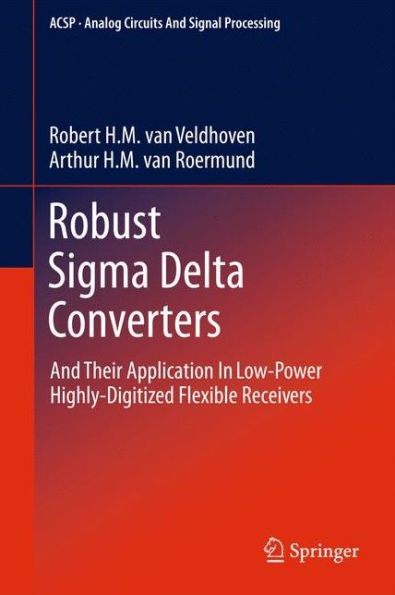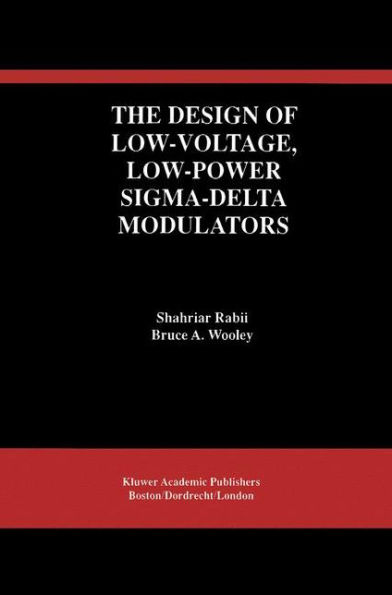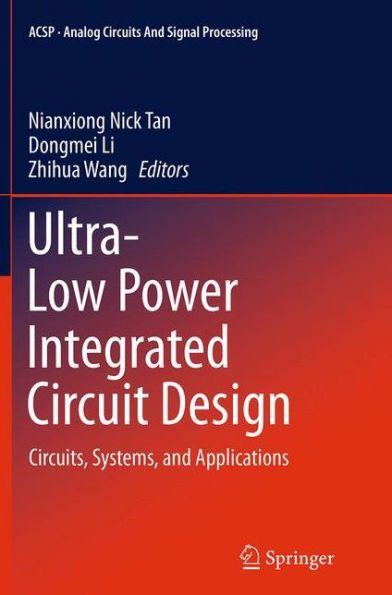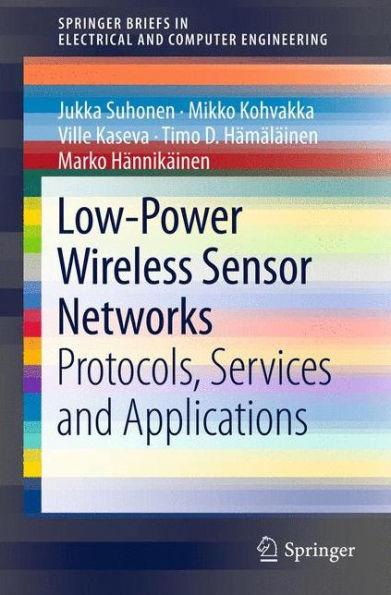Home
Robust Sigma Delta Converters: And Their Application in Low-Power Highly-Digitized Flexible Receivers / Edition 1
Barnes and Noble
Loading Inventory...
Robust Sigma Delta Converters: And Their Application in Low-Power Highly-Digitized Flexible Receivers / Edition 1 in Franklin, TN
Current price: $179.99

Barnes and Noble
Robust Sigma Delta Converters: And Their Application in Low-Power Highly-Digitized Flexible Receivers / Edition 1 in Franklin, TN
Current price: $179.99
Loading Inventory...
Size: OS
Sigma Delta converters are a very popular choice for the A/D converter in multi-standard, mobile and cellular receivers. Key A/D converter specifications are high dynamic range, robustness, scalability, low-power and low EMI.
Robust Sigma Delta Converters
presents a requirement derivation of a Sigma Delta modulator applied in a receiver for cellular and connectivity, and shows trade-offs between RF and ADC. The book proposes to categorize these requirements in 5 quality indicators which can be used to qualify a system, namely accuracy, robustness, flexibility, efficiency and emission. In the book these quality indicators are used to categorize Sigma Delta converter theory. A few highlights on each of these quality indicators are;
• Quality indicators: provide a means to quantify system quality.
• Accuracy: introduction of new Sigma Delta Modulator architectures.
• Robustness: a significant extension on clock jitter theory based on phase and error amplitude error models. Extension of the theory describing aliasing in Sigma Delta converters for different types of DACs in the feedback loop.
• Flexibility: introduction of a Sigma Delta converter bandwidth scaling theory leading to very flexible Sigma Delta converters.
• Efficiency: introduction of new Figure-of-Merits which better reflect performance-power trade-offs.
• Emission: analysis of Sigma Delta modulators on emission is not part of the book
The quality indicators also reveal that, to exploit nowadays advanced IC technologies, things should be done as much as possible digital up to a limit where system optimization allows reducing system margins. At the end of the book Sigma Delta converter implementations are shown which are digitized on application-, architecture-, circuit- and layout-level.
is written under the assumption that the reader has some background in receivers and in A/D conversion.
Robust Sigma Delta Converters
presents a requirement derivation of a Sigma Delta modulator applied in a receiver for cellular and connectivity, and shows trade-offs between RF and ADC. The book proposes to categorize these requirements in 5 quality indicators which can be used to qualify a system, namely accuracy, robustness, flexibility, efficiency and emission. In the book these quality indicators are used to categorize Sigma Delta converter theory. A few highlights on each of these quality indicators are;
• Quality indicators: provide a means to quantify system quality.
• Accuracy: introduction of new Sigma Delta Modulator architectures.
• Robustness: a significant extension on clock jitter theory based on phase and error amplitude error models. Extension of the theory describing aliasing in Sigma Delta converters for different types of DACs in the feedback loop.
• Flexibility: introduction of a Sigma Delta converter bandwidth scaling theory leading to very flexible Sigma Delta converters.
• Efficiency: introduction of new Figure-of-Merits which better reflect performance-power trade-offs.
• Emission: analysis of Sigma Delta modulators on emission is not part of the book
The quality indicators also reveal that, to exploit nowadays advanced IC technologies, things should be done as much as possible digital up to a limit where system optimization allows reducing system margins. At the end of the book Sigma Delta converter implementations are shown which are digitized on application-, architecture-, circuit- and layout-level.
is written under the assumption that the reader has some background in receivers and in A/D conversion.
Sigma Delta converters are a very popular choice for the A/D converter in multi-standard, mobile and cellular receivers. Key A/D converter specifications are high dynamic range, robustness, scalability, low-power and low EMI.
Robust Sigma Delta Converters
presents a requirement derivation of a Sigma Delta modulator applied in a receiver for cellular and connectivity, and shows trade-offs between RF and ADC. The book proposes to categorize these requirements in 5 quality indicators which can be used to qualify a system, namely accuracy, robustness, flexibility, efficiency and emission. In the book these quality indicators are used to categorize Sigma Delta converter theory. A few highlights on each of these quality indicators are;
• Quality indicators: provide a means to quantify system quality.
• Accuracy: introduction of new Sigma Delta Modulator architectures.
• Robustness: a significant extension on clock jitter theory based on phase and error amplitude error models. Extension of the theory describing aliasing in Sigma Delta converters for different types of DACs in the feedback loop.
• Flexibility: introduction of a Sigma Delta converter bandwidth scaling theory leading to very flexible Sigma Delta converters.
• Efficiency: introduction of new Figure-of-Merits which better reflect performance-power trade-offs.
• Emission: analysis of Sigma Delta modulators on emission is not part of the book
The quality indicators also reveal that, to exploit nowadays advanced IC technologies, things should be done as much as possible digital up to a limit where system optimization allows reducing system margins. At the end of the book Sigma Delta converter implementations are shown which are digitized on application-, architecture-, circuit- and layout-level.
is written under the assumption that the reader has some background in receivers and in A/D conversion.
Robust Sigma Delta Converters
presents a requirement derivation of a Sigma Delta modulator applied in a receiver for cellular and connectivity, and shows trade-offs between RF and ADC. The book proposes to categorize these requirements in 5 quality indicators which can be used to qualify a system, namely accuracy, robustness, flexibility, efficiency and emission. In the book these quality indicators are used to categorize Sigma Delta converter theory. A few highlights on each of these quality indicators are;
• Quality indicators: provide a means to quantify system quality.
• Accuracy: introduction of new Sigma Delta Modulator architectures.
• Robustness: a significant extension on clock jitter theory based on phase and error amplitude error models. Extension of the theory describing aliasing in Sigma Delta converters for different types of DACs in the feedback loop.
• Flexibility: introduction of a Sigma Delta converter bandwidth scaling theory leading to very flexible Sigma Delta converters.
• Efficiency: introduction of new Figure-of-Merits which better reflect performance-power trade-offs.
• Emission: analysis of Sigma Delta modulators on emission is not part of the book
The quality indicators also reveal that, to exploit nowadays advanced IC technologies, things should be done as much as possible digital up to a limit where system optimization allows reducing system margins. At the end of the book Sigma Delta converter implementations are shown which are digitized on application-, architecture-, circuit- and layout-level.
is written under the assumption that the reader has some background in receivers and in A/D conversion.

















